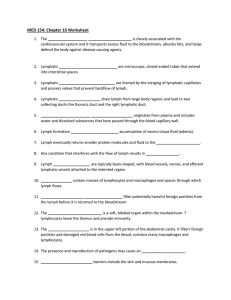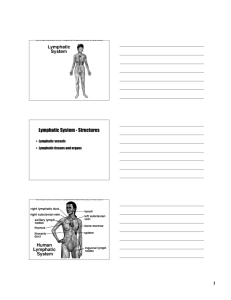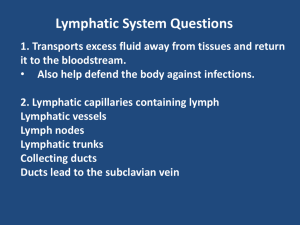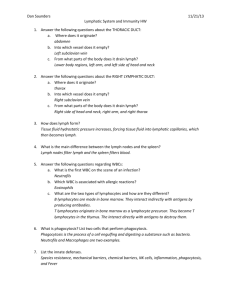13. Blood-Immune Resp.doc
advertisement
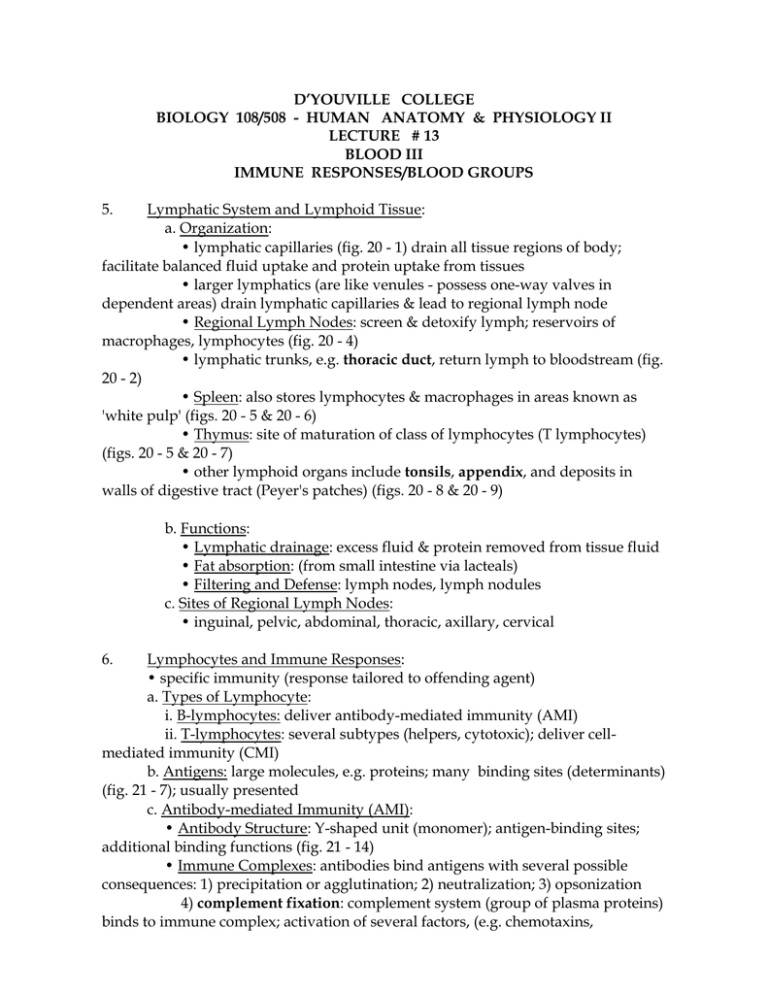
D’YOUVILLE COLLEGE BIOLOGY 108/508 - HUMAN ANATOMY & PHYSIOLOGY II LECTURE # 13 BLOOD III IMMUNE RESPONSES/BLOOD GROUPS 5. Lymphatic System and Lymphoid Tissue: a. Organization: • lymphatic capillaries (fig. 20 - 1) drain all tissue regions of body; facilitate balanced fluid uptake and protein uptake from tissues • larger lymphatics (are like venules - possess one-way valves in dependent areas) drain lymphatic capillaries & lead to regional lymph node • Regional Lymph Nodes: screen & detoxify lymph; reservoirs of macrophages, lymphocytes (fig. 20 - 4) • lymphatic trunks, e.g. thoracic duct, return lymph to bloodstream (fig. 20 - 2) • Spleen: also stores lymphocytes & macrophages in areas known as 'white pulp' (figs. 20 - 5 & 20 - 6) • Thymus: site of maturation of class of lymphocytes (T lymphocytes) (figs. 20 - 5 & 20 - 7) • other lymphoid organs include tonsils, appendix, and deposits in walls of digestive tract (Peyer's patches) (figs. 20 - 8 & 20 - 9) b. Functions: • Lymphatic drainage: excess fluid & protein removed from tissue fluid • Fat absorption: (from small intestine via lacteals) • Filtering and Defense: lymph nodes, lymph nodules c. Sites of Regional Lymph Nodes: • inguinal, pelvic, abdominal, thoracic, axillary, cervical 6. Lymphocytes and Immune Responses: • specific immunity (response tailored to offending agent) a. Types of Lymphocyte: i. B-lymphocytes: deliver antibody-mediated immunity (AMI) ii. T-lymphocytes: several subtypes (helpers, cytotoxic); deliver cellmediated immunity (CMI) b. Antigens: large molecules, e.g. proteins; many binding sites (determinants) (fig. 21 - 7); usually presented c. Antibody-mediated Immunity (AMI): • Antibody Structure: Y-shaped unit (monomer); antigen-binding sites; additional binding functions (fig. 21 - 14) • Immune Complexes: antibodies bind antigens with several possible consequences: 1) precipitation or agglutination; 2) neutralization; 3) opsonization 4) complement fixation: complement system (group of plasma proteins) binds to immune complex; activation of several factors, (e.g. chemotaxins, Bio 108/508 lec. 13 - p. 2 vasoactive substances, opsonins, lysins), resulting in inflammation, phagocytosis, leukocytosis, destruction of offending agent (fig. 21 - 6) Bio 108/508 lec. 13 - p. 3 d. Cell-mediated Immunity (CMI): • T-lymphocytes mature in thymus - when activated by antigen binding (presented by dendritic cell - fig. 21 - 10), produce interleukins (mitogens, migration inhibitors, transfer factor, chemotaxins, lysins) - interleukins of helper T cells (CD4 receptors) stimulate other immune system cells - products of cytotoxic T cells (CD8 receptors) destroy antigens or cells bearing antigens (e.g. virus-infected cells) (fig. 21 - 16) e. Sensitization: • initial exposure to antigen generates weak, slowly developing response; (ineffective if initial dosage is strong!) • subsequent exposures generate strong, rapid responses that may dispatch potentially lethal antigen doses (fig. 21 - 12) • clonal selection theory: explanation of sensitization (figs. 21 - 11 & 21 16): i. antigen (usually processed by macrophages or dendritic cells) attempts binding with various lymphocytes; unsuccessful until “good fit” with receptor ii. antigen binding stimulates lymphocyte to undergo mitosis, proliferating a large population of identical cells (same antigen receptor); called a “clone” iii. clone believed to contain both active and dormant (memory) cells; memory cells may populate lymphoid depots around body increasing likelihood of successful response to another encounter with same antigen (sensitization) iv. effector cells: • B-cells: those that secrete antibodies, are known as plasma cells • T-cells: secrete cytokines (interleukins) when they bind an antigen (cytotoxic cells) f. Vaccination: practice of clinically inducing sensitization to a particular antigen, thus, guaranteeing a vigorous immune response (immunization)

